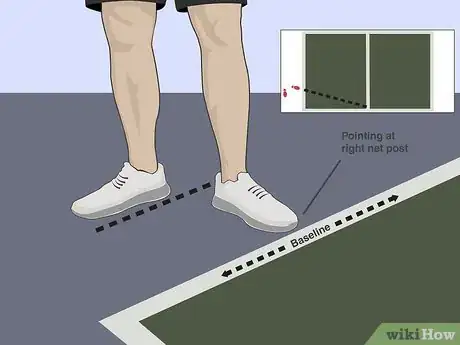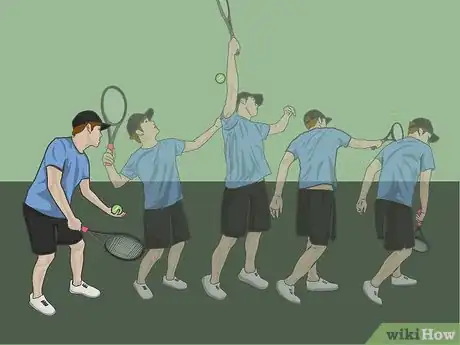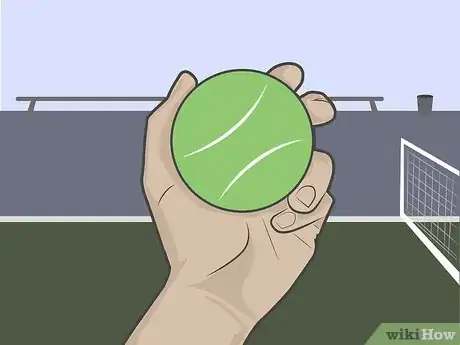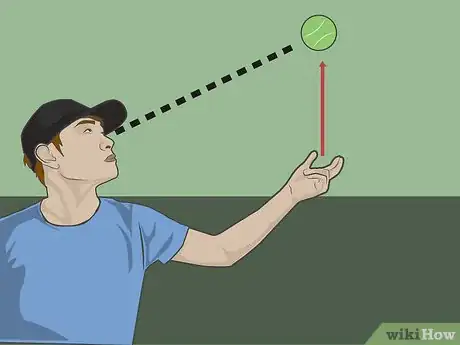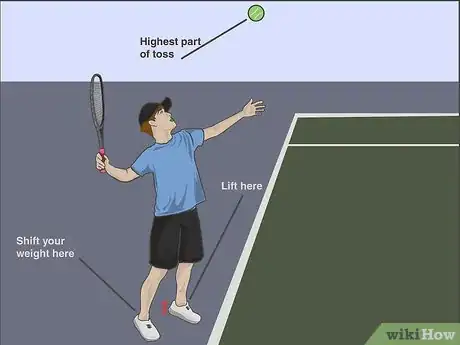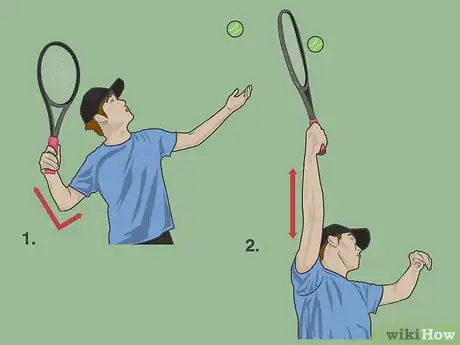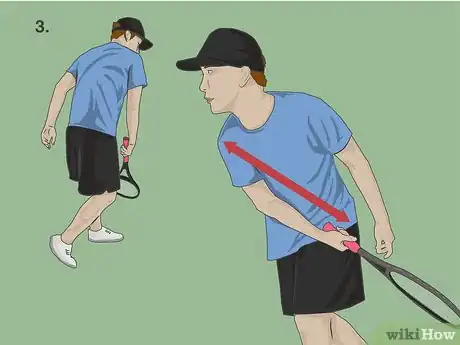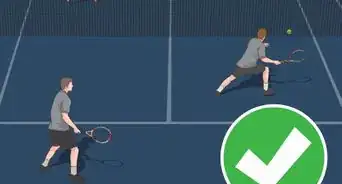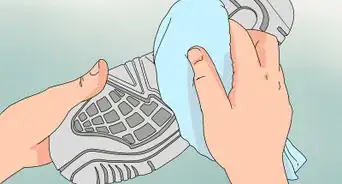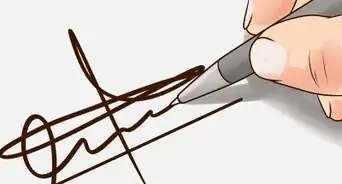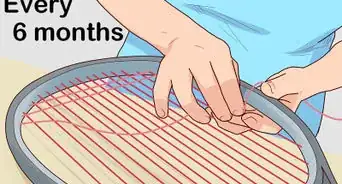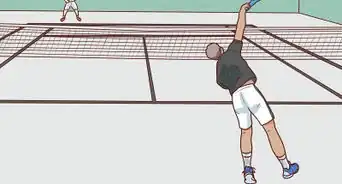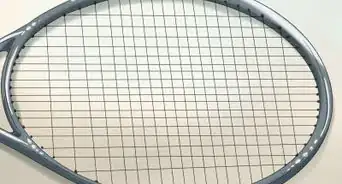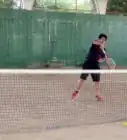This article was co-authored by Peter Fryer. Peter Fryer is a tennis writer and coach based in Derry Northern Ireland. He completed his professional teaching tennis qualification shortly after finishing university and has been teaching tennis for over 13 years. Peter began Love Tennis Blog in 2010 and contributes to the BBC and national media outlets.
This article has been viewed 82,886 times.
In tennis, your serve is your ultimate weapon. You have absolute control as you begin the point, and with an excellent serve, you can end the point as well. The fastest serve, and possibly the most intimidating, is the flat serve. However, the flat serve must be precise and perfectly executed to be effective, so it’s important to practice it thoroughly before facing off.
Steps
Preparing to Serve
-
1Grip your racquet. Create a V with your thumb and forefinger. Place your hand on the racquet so that this V is at 11 o’clock, or one o’clock for left-handed players.[1] To simplify it, think about holding your racquet as you would a hammer. This is called the continental grip , which is the grip you want to utilize for a flat serve. Practice maintaining this grip while keeping your hand loose and relaxed.
- In the continental grip, the racquet is at a neutral angle to the ground. In other words, it is perpendicular to the ground when you hold your arm in front of you.[2]
- The continental grip is valuable for its versatility. You can use it for other types of serves and volleys as well.
-
2Stand sideways with feet hip width apart. In a match, you will be standing at the baseline, the line farthest from the net.[3] Right handed players should keep their right foot back, parallel to the baseline. The left foot should be forward, near the baseline and pointing to the right net post. Left handers will be standing in this stance, simply reversed. Once you have your feet in the correct stance, bounce a few times. Get loose and comfortable in this position.
- The stance for the flat serve is just like the stance for all other serves— you can’t make it obvious what serve you are preparing for, or your opponent would know exactly what was coming their way!
Advertisement -
3Visualize your flat serve. By picturing a strong, successful serve, you can help to decrease anxiety. By decreasing your anxiety, you also decrease the likelihood of making little, nervous mistakes. Take deep, calming breaths. Don’t just visualize the image of the serve— imagine the force of the serve and the sound of the ball hitting the racquet. Walk yourself through your serve in your head multiple times. This visualization is a helpful tool in building your confidence and preparing yourself for a great serve.
Tossing the Ball
-
1Hold the ball in your fingertips. By holding it like this, you are able to more accurately control the toss. When you are setting up for a flat serve, you want to toss the ball in a simple, straight trajectory without any spin. This is most easily achieved when the ball is released from the finger tips, rather than the palm.
-
2Toss the ball into the air. This should be done by raising the arm straight, and releasing the ball from your fingertips when you are about head height. Because the ball will drop as you raise your racquet to hit it, you want to toss the ball a couple of feet higher than the place you intend to make contact with it. It should be tossed slightly in front of your body.
-
3Keep your eyes on the ball. An easy way to do this is by keeping your tossing arm raised during the serve. If you allow your arm to drop, it is easy to drop your head as well. Stay relaxed and focus on the serve, rather than glancing at your opponent or the net. It’s imperative to track the ball with your eyes the whole time!
- This is a mistake that is most often made when a player is tense and nervous. As you practice your flat serve and gain confidence, you will more easily keep your eye on the ball the whole time.
Hitting the Ball
-
1Transfer your weight in your back foot. This should be done as the ball reaches the highest part of the toss. As your shift your weight to your back foot, lift the ball of your front foot. In this stance, your body is ready to launch off the ground and into the ball. This helps give the serve its power.
-
2Swing the racquet arm up and over your opposite shoulder. Your racquet arm should begin in a bent position behind you as you prepare to serve. Your racquet should be straight up, a little higher than your head. As the tossed ball starts to drop, swing your racquet in a whipping motion. Your arm should be completely extended when it comes into contact with the ball.[4] Focus on hitting the ball squarely from behind. You aren't aiming to create any sort of spin— simply try to hit the back of the ball dead on, making only brief contact with the ball.
-
3Bring your racquet down across your body. The follow-through of a flat serve is extremely important. Make sure that, after hitting the ball, you continue to swing through until the racquet is at your opposite hip. If you pump the brakes too early, the serve will not have its full force.
-
4Prepare for your opponent's return. Transfer your weight so that it is distributed evenly over both feet. Keep your knees bent and shoulder width apart so that you are ready to move. Bring your racquet to the center of your body and hold it with both hands, allowing for quick grip changes and rotations. By staying light on your feet, you will be ready to get anywhere for your opponent’s return.[5]EXPERT TIPPeter Fryer is a tennis writer and coach based in Derry Northern Ireland. He completed his professional teaching tennis qualification shortly after finishing university and has been teaching tennis for over 13 years. Peter began Love Tennis Blog in 2010 and contributes to the BBC and national media outlets.Tennis Instructor

 Peter Fryer
Peter Fryer
Tennis InstructorAvoid getting into a rhythm. Peter Fryer, a tennis pro, says: “Most tennis players love rhythm, which you can use to your advantage. Try varying your shots and don’t give your opponent the same shot twice.”
Community Q&A
-
QuestionWhen I follow through in the serve, do I bend my arm, or keep it straight?
 DonaganTop AnswererYour arm bends during the serve, but it's fairly straight in the follow-through.
DonaganTop AnswererYour arm bends during the serve, but it's fairly straight in the follow-through.
References
- ↑ http://www.theguardian.com/lifeandstyle/2009/jun/28/tennis-learn-grips
- ↑ http://www.tenniscompanion.org/an-overview-and-guide-to-the-continental-grip/
- ↑ http://www.theguardian.com/lifeandstyle/2009/jun/27/tennis-court-markings-explanation
- ↑ http://protennistips.net/how-to-tennis-serve/
- ↑ http://news.bbc.co.uk/sport2/hi/tennis/skills/4230606.stm

